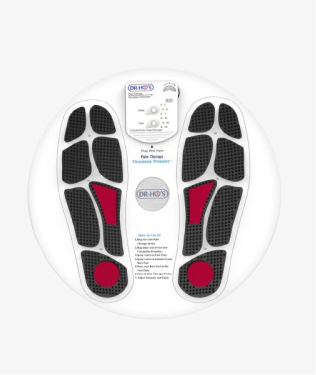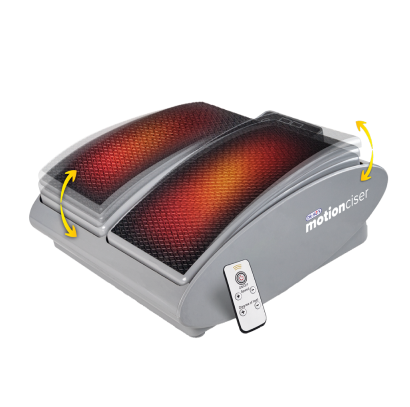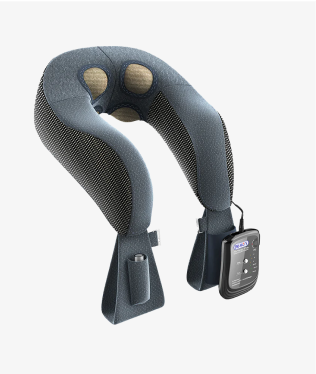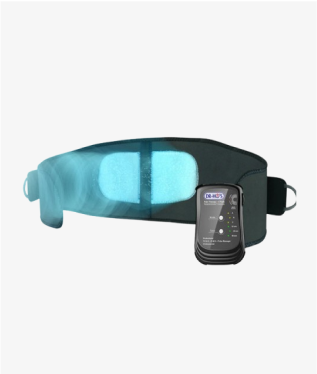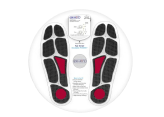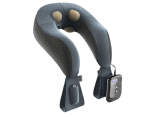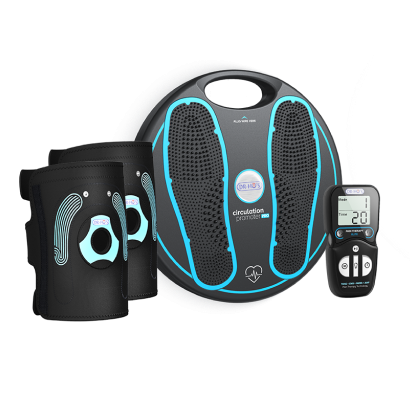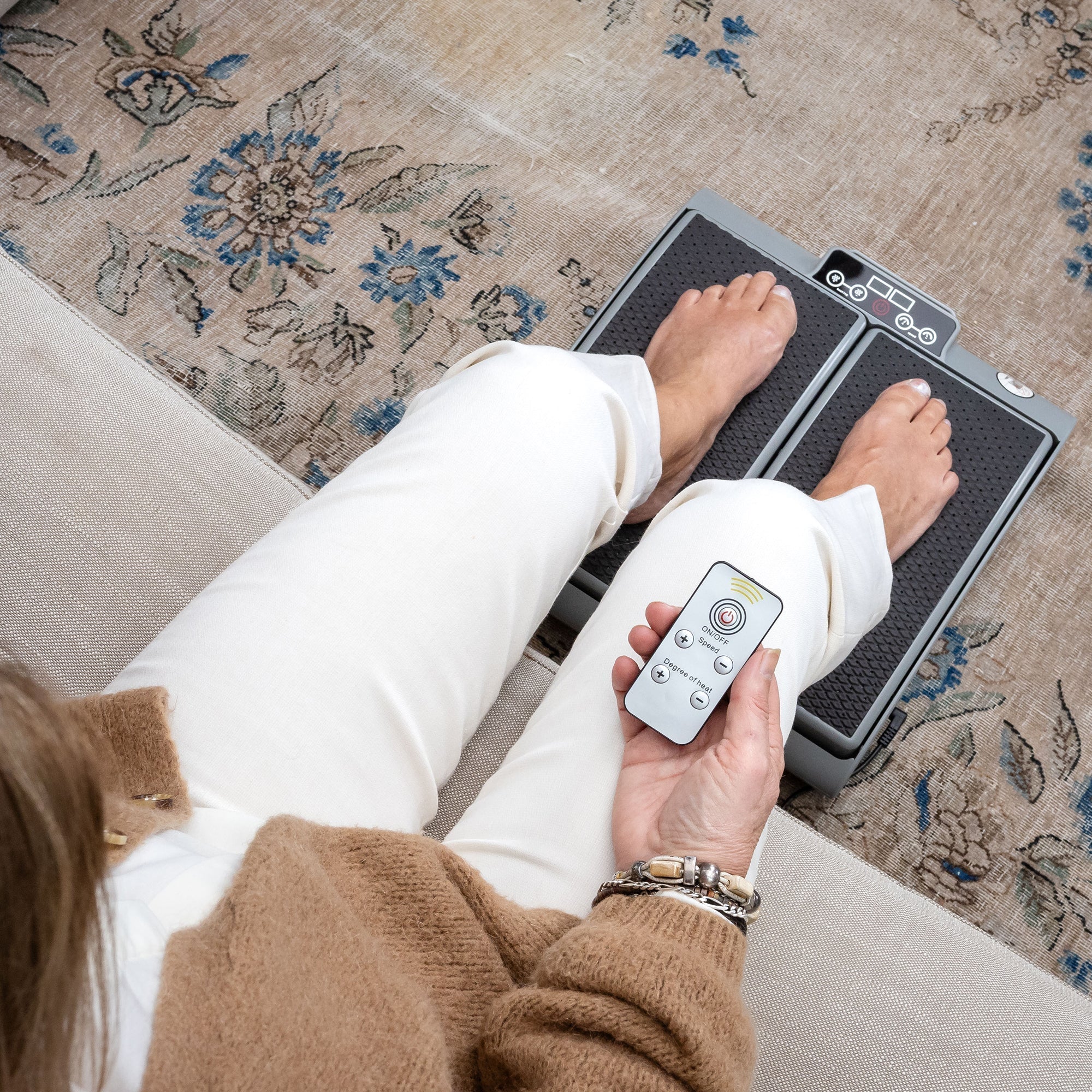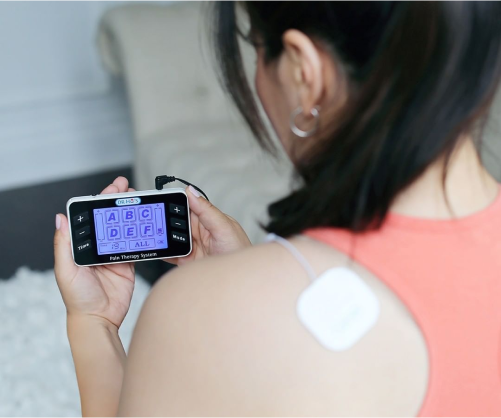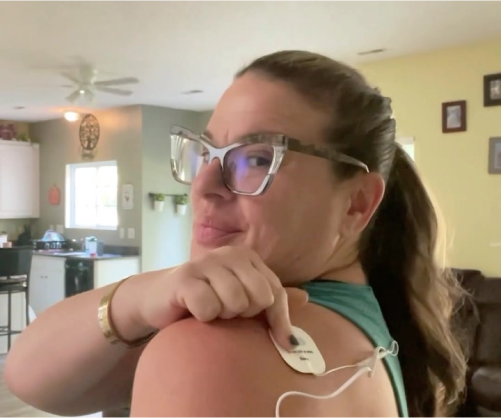If you've ever experienced a sharp, stabbing pain in your heel when taking your first steps in the morning, you're likely familiar with plantar fasciitis. This common but debilitating foot condition affects millions of people worldwide, limiting mobility and diminishing quality of life. While conventional treatments like rest, stretching, and orthotics have their place, many sufferers continue to search for more effective pain relief solutions.
DR-HO'S TENS machines offer a scientifically backed approach to managing plantar fasciitis pain through advanced electrical stimulation technology. Our proprietary AMP Technology goes beyond standard TENS therapy by combining multiple stimulation techniques in one comprehensive solution. This 4-in-1 technology works with your body's natural processes to provide temporary relief from foot pain while potentially supporting the healing process.
In this comprehensive post, you'll discover exactly how DR-HO'S TENS technology can help alleviate plantar fasciitis pain, the proper electrode placement techniques for maximum effectiveness, and how to integrate TENS therapy into a complete treatment approach for lasting relief from chronic pain.
Understanding plantar fasciitis
Plantar fasciitis is an inflammatory condition affecting the plantar fascia—a thick band of connective tissue that runs along the bottom of your foot, connecting your heel bone to your toes. This crucial structure supports your foot's arch and absorbs the significant forces placed on your feet during daily activities.
When the plantar fascia experiences excessive strain or repetitive stress, it can develop small tears and inflammation, leading to the characteristic heel pain associated with this condition. The pain is typically most intense with the first steps in the morning or after prolonged periods of rest, as the fascia tightens and contracts during inactivity.

Prevalence and population impact
Plantar fasciitis is remarkably common, affecting approximately 10% of people during their lifetime (Am Fam Physician). The condition doesn't discriminate between active and sedentary individuals, though certain populations show higher incidence rates:
-
Peak incidence occurs in women aged 40-60 years (Am Fam Physician)
-
Both recreational and elite athletes are vulnerable, with an estimated 5-10% incidence among runners (Am Fam Physician)
-
It's one of the most common causes of heel pain seen by medical practitioners
These statistics highlight why effective treatments like DR-HO'S TENS technology are so crucial for public health—plantar fasciitis affects millions of people who need reliable, non-invasive pain relief options.
Common causes and risk factors for heel pain
Several factors can contribute to the development of plantar fasciitis:
-
Foot mechanics: Flat feet, high arches, or abnormal walking patterns can place additional stress on the plantar fascia
-
Age: The condition is most common in adults between 40-60 years old
-
Weight: Excess body weight increases pressure on the feet
-
Activities: Long-distance running, ballet, dance, and occupations requiring prolonged standing
-
Footwear: Inadequate arch support or cushioning in shoes
-
Tight calf muscles: Reduced ankle flexibility can strain the plantar fascia
Plantar fasciitis symptoms and diagnosis
The primary symptom of plantar fasciitis is pain at the bottom of the heel or along the arch of the foot. This pain is often described as:
-
Sharp, stabbing pain, especially with the first steps in the morning
-
Pain that improves with activity but worsens after prolonged standing or exercise
-
Discomfort when climbing stairs or standing on tiptoes
-
Tenderness when the bottom of the foot is pressed
What makes plantar fasciitis particularly challenging to treat is its persistent nature and the mechanical stress that occurs with every step. Even as healing begins, the simple act of walking can reinjure the tissue, creating a frustrating cycle of pain and incomplete recovery.
How DR-HO'S TENS technology works for plantar fasciitis
Transcutaneous Electrical Nerve Stimulation (TENS) has emerged as a powerful tool in the management of plantar fasciitis pain. DR-HO'S takes this technology to the next level with our proprietary AMP Technology, which combines multiple therapeutic modalities in one comprehensive solution.
The science behind TENS for foot pain
TENS therapy works through several physiological mechanisms to treat foot pain and provide pain relief:
-
Gate control theory: Electrical stimulation activates large-diameter sensory nerve fibers, which effectively "close the gate" on the body's pain signals traveling to the brain. This interruption of pain transmission provides immediate relief during treatment.
-
Endorphin release: The gentle electrical pulses trigger the production of endorphins, your body's natural painkillers. These powerful chemicals work similarly to morphine but without the side effects or risk of dependency.
-
Improved blood circulation: The stimulation causes muscles to contract and relax rhythmically, improving blood flow to the area. Better circulation delivers more oxygen and nutrients to the injured tissues while removing inflammatory byproducts.
DR-HO'S AMP technology: Beyond basic TENS
What sets DR-HO'S TENS units apart is our advanced AMP 4-in-1 technology that combines:
-
Traditional TENS (Transcutaneous Electrical Nerve Stimulation): For immediate pain relief through nerve stimulation
-
EMS (Electrical Muscle Stimulation): Gently contracts muscles to improve strength and circulation
-
NMES (Neuromuscular Electrical Stimulation): Enhances nerve-muscle communication
-
Auto-Modulating Pulse: Continuously varies the electrical parameters to prevent adaptation and maximize effectiveness
This comprehensive approach to foot pain relief is particularly beneficial for plantar heel pain because it addresses multiple aspects of the condition simultaneously. While conventional TENS devices might provide temporary pain relief, DR-HO'S 4-in-1 technology goes further by:
-
Reducing inflammation through enhanced circulation
-
Preventing muscle atrophy in the foot's intrinsic muscles
-
Breaking the pain-spasm cycle that can develop with chronic foot pain
-
Potentially accelerating healing by increasing nutrient delivery to the injured plantar fascia
For plantar fasciitis specifically, this multifaceted approach can significantly improve both immediate pain relief and long-term management of the condition.
Proper electrode placement and settings for plantar fasciitis
Achieving optimal results with your DR-HO'S TENS device depends significantly on proper electrode placement and appropriate settings. When using a TENS unit for plantar fasciitis, targeted application is essential to reach the affected tissues effectively.
DR-HO'S offers multiple approaches for treating plantar fasciitis:
1. Using DR-HO'S Circulation Promoter base plate
For comprehensive treatment of plantar fasciitis and other foot pain conditions, we recommend using our specialized Circulation Promoter base plate. This innovative platform delivers stimulation directly to the entire sole of the foot, ensuring complete coverage of the plantar fascia. Simply:
-
Place the base plate on the floor
-
Position your bare foot on the plate
-
Adjust the intensity to a comfortable level
-
Relax as the therapy works through your entire foot
The Circulation Promoter is particularly effective for plantar fasciitis because it delivers consistent stimulation across the entire affected area without the need for adhesive pads.

2. Traditional pad placement when using a TENS machine
If using traditional electrode pads, follow these placement guidelines:
For targeted plantar fascia treatment:
-
Place one pad at the bottom of the heel (where pain is often most intense)
-
Place the second pad at the base of the toes or mid-arch
-
This creates a current path that flows directly through the plantar fascia

For ankle and foot pain, including plantar fasciitis:
-
Position one pad around the outside of the ankle
-
Wrap another pad around the inside of the foot
-
This placement helps address both direct pain and referred pain patterns

Note: As mentioned in our guidelines, foot areas may have oils that reduce pad adhesion. You can hold pads in place manually or sit to minimize movement during treatment.
Optimal settings and treatment protocol
For effective plantar fasciitis treatment with your DR-HO'S device:
Recommended settings:
-
Intensity: Start low and gradually increase to a comfortable level where you feel a strong but not painful sensation
-
Program/Mode: Use the specific foot pain or inflammation setting if available on your model
-
Therapy mode: Choose from a variety of massage-like sensations, catering to individual preferences for a personalized pain relief experience.
Treatment schedule:
-
Duration: 20-30 minutes per session is typically optimal
-
Frequency: 2-3 times daily, especially:
-
First thing in the morning (before taking your first steps)
-
After long periods of standing or walking
-
Before bed to help reduce morning pain
-
Consistency: Regular use over several weeks yields the best results
Maximizing the effectiveness of electrode pads on feet
The unique anatomy of feet can present challenges for traditional adhesive electrodes. To enhance effectiveness:
-
Clean the skin thoroughly before application to remove oils and lotions
-
Lightly moisturize very dry skin (extremely dry skin can reduce conductivity)
-
Consider using electrode gel to improve conductivity
-
For difficult areas, use DR-HO'S specially designed foot accessories like the Circulation Promoter
-
Secure pads with an elastic wrap if necessary
Comprehensive treatment approach for plantar fasciitis
While DR-HO'S TENS technology offers powerful pain relief for plantar fasciitis, achieving optimal and lasting results typically requires a multi-faceted approach. Integrating TENS therapy with other treatments creates a synergistic effect that addresses both symptoms and underlying causes.
For maximum benefit, incorporate your DR-HO'S TENS treatments into a comprehensive plan:
1. Strategic TENS application for foot pain relief
-
Use TENS before your first morning steps to reduce initial pain
-
Apply TENS after activities that aggravate symptoms
-
Utilize TENS before stretching exercises to enhance comfort and effectiveness
2. Consider complementary physical treatments
Consider adding these supportive approaches to your personalized relief plan based on your specific needs and comfort level. Many DR-HO'S customers find these complementary options enhance the effectiveness of their TENS therapy:
-
Cold therapy: Apply ice for 15-20 minutes after activities to reduce inflammation
-
Supportive footwear: Shoes with proper arch support and cushioning
-
Night splints: Keep the plantar fascia gently stretched during sleep
-
Foot taping: Provide temporary support to the arch
3. Explore a progressive exercise program
The following gentle stretching and strengthening exercises can complement your DR-HO'S TENS therapy. Consider incorporating these based on your comfort level, or follow a structured program guided by yoga, Pilates, or physical therapy practitioners who can tailor exercises to your specific needs:
-
Plantar fascia stretches: Gently pull your toes toward your shin while seated
-
Calf stretches: Lean against a wall with your affected foot back and heel down
-
Toe curls: Pick up marbles or scrunch a towel with your toes
-
Roll massage: Roll your foot over a frozen water bottle or specialized foot roller
Pro tip: Use your DR-HO'S TENS device before exercises to reduce pain and improve your ability to complete the stretches effectively. The 4-in-1 technology helps prepare your muscles and nerves for movement by temporarily increasing circulation to the area.
4. Other possible lifestyle modifications
Some lifestyle adjustments may help support your recovery and maximize the effectiveness of your DR-HO'S TENS therapy. Consider discussing these options with your healthcare provider, who can help you determine which modifications might be most beneficial for your specific situation:
-
Activity modification: Temporarily reduce high-impact activities like running
-
Surface awareness: Avoid walking barefoot, especially on hard surfaces
-
Foot support: Consider custom or over-the-counter orthotics
-
Regular foot checks: Monitor for early signs of recurring pain
-
Weight management: We recommend consulting with your healthcare provider before beginning any weight loss program, as they can help you develop a safe, effective approach if excess weight is contributing to your plantar fasciitis
DR-HO'S advanced 4-in-1 technology can be an excellent complement to these lifestyle modifications, providing targeted relief through its proprietary combination of TENS, EMS, and NMES, all working together to support your body's natural healing processes.
When to consult a healthcare professional
While DR-HO'S TENS devices provide effective home treatment for plantar fasciitis, certain situations warrant professional medical attention:
-
Severe pain that doesn't improve with rest and home treatment
-
Heel pain accompanied by severe swelling, redness, or warmth
-
Pain that radiates to other parts of the foot or leg
-
Numbness or tingling in the foot
-
Pain that persists beyond several months of home treatment
A healthcare provider can rule out other conditions with similar symptoms and may recommend additional interventions, such as physical therapy, custom orthotics, or, in rare cases, surgical options.
Conclusion: Don’t resign yourself to chronic foot pain
Living with plantar fasciitis doesn't mean resigning yourself to chronic foot pain. DR-HO'S advanced TENS technology offers a scientifically-backed, non-invasive approach to managing this challenging condition. Our proprietary AMP Technology goes beyond standard TENS therapy by combining multiple therapeutic modalities that work with your body's natural processes to provide comprehensive relief.
By properly using your DR-HO'S device—with correct electrode placement, optimal settings, and as part of a complete treatment strategy—you can experience a significant reduction in plantar fasciitis pain and improvement in foot function. The unique 4-in-1 technology addresses multiple aspects of your condition simultaneously, helping to break the cycle of pain while potentially supporting the healing process.
Take the first step toward pain-free walking today with DR-HO'S specialized pain relief solutions. Your feet support you through every step of life's journey—now it's time to give them the support they deserve.
Disclaimer: DR-HO'S content is intended for informational purposes only and should not be taken as medical advice. Please consult a certified medical professional for diagnosis and treatment recommendations.
More FAQs
Does a TENS machine work on plantar fasciitis?
Yes, DR-HO'S TENS machines can be highly effective for plantar fasciitis pain relief. Unlike standard TENS units, DR-HO'S devices utilize proprietary 4-in-1 technology that combines traditional TENS with EMS, NMES, and our exclusive AMP Technology. This comprehensive approach works with your body's natural processes to not only block pain signals but also enhance local blood circulation to the affected plantar fascia. By stimulating nerve fibers and promoting endorphin release, DR-HO'S advanced stimulation technology provides targeted temporary relief while potentially supporting the healing environment around the injured tissue.
Can I put a TENS unit on the bottom of my feet?
Absolutely! DR-HO'S offers specialized solutions specifically designed for the unique anatomy of your feet. Our Circulation Promoter base plate provides complete coverage of the plantar fascia without requiring adhesive pads, making it ideal for treating the bottom of your feet. For traditional electrode pad application, DR-HO'S recommends placing one pad at the heel and another at the base of the toes, creating an optimal stimulation path through the plantar fascia. Our innovative AMP Technology ensures the electrical parameters automatically modulate throughout your treatment, providing consistent stimulation that maintains effectiveness even on the thicker skin of your feet.
What is the absolute best treatment for plantar fasciitis?
The most effective approach for plantar fasciitis combines multiple treatment strategies tailored to your specific needs. DR-HO'S advanced 4-in-1 technology provides a cornerstone for effective pain management through its unique combination of TENS, EMS, and NMES with our proprietary AMP Technology. This comprehensive stimulation system temporarily relieves pain while promoting local circulation to the affected tissues. For optimal results, complement your DR-HO'S therapy with appropriate footwear, targeted stretching exercises, and rest during acute flare-ups. Our clinically-developed technology works with your body's natural processes to help interrupt the pain cycle while you implement a complete recovery plan supervised by your healthcare provider.
Does TENS help fascia?
DR-HO'S advanced stimulation technology offers multiple benefits for fascial tissue, including the plantar fascia. Our proprietary 4-in-1 technology goes beyond standard TENS by incorporating EMS and NMES with our exclusive AMP Technology, creating a comprehensive approach to fascial health. This innovative system not only provides temporary pain relief through nerve stimulation but also enhances local circulation to the fascial tissues, which may support the natural healing environment. The gentle electrical impulses help relax tight fascia while potentially reducing inflammation through improved blood flow. While DR-HO'S technology primarily addresses pain symptoms, the increased circulation and muscle stimulation may contribute to creating optimal conditions for the body's natural recovery processes within fascial tissues.
Disclaimer: DR-HO'S content is intended for informational purposes only and should not be taken as medical advice. Please consult a certified medical professional for diagnosis and treatment recommendations.


